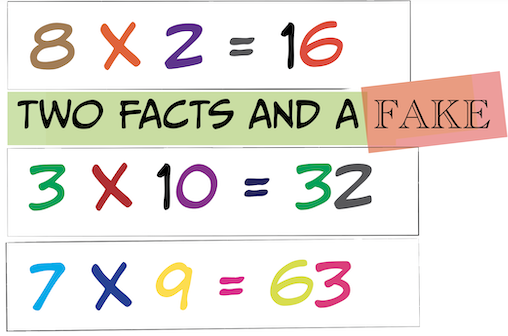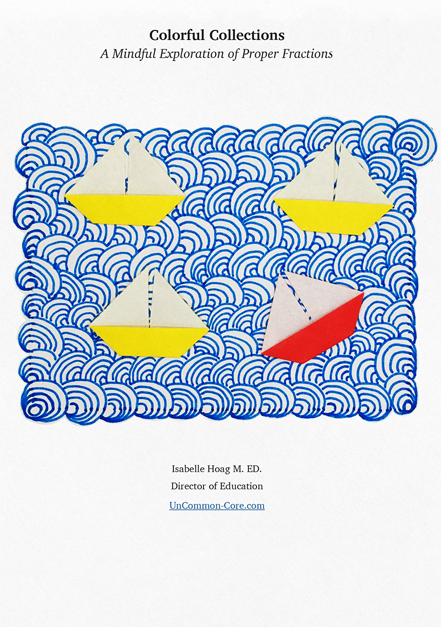
Put a Mathematical Twist on a Familiar Game
Call it anything you want: Two Truths and a Fib, or Facts and a Falsehood, the math version of this game is just as fun as the original. Students will love to practice math facts with Two Facts and a FAKE. Keep your entire class engaged playing this fast paced, find the facts, fix the fraud type game.
Playing games make math facts sticky. We want our students to be able to recall math facts automatically. Playing games gives students a new point of view about math, gets them talking and thinking about math.
The Big Picture
Basically, the game is played with your whole class in round robin format. Of course there are many ways to play Two Facts and a Fake; with different size groups, in real time or asynchronously, and any other way you or your students can imagine. I have listed some variations at the end of this post.
There will be two groups of students; one group that stays seated, and one that changes places after each round. One round should take less than three minutes after your students understand the rules of the game. Students in the two groups are paired off. Each player will have prepared 3 facts (one of which is wrong). The players take turns sharing their equations, doing the math, and identifying which one is FAKE. Have students write their initials on the back of each math fact. On the flip side of the FAKE they should add the correct answer as well. Play continues until everyone agrees on all the equations.
Get Ready!
Before the game can begin, each student must write two math facts and one fake. I suggest using strong paper such as card stock, construction paper, or even colorful cardboard. This way, the equations will stand up to being examined so often and the initials (or answer!) on the back won’t show through to the front. Also, I would suggest using paper strips that are at least 8.5 by 3 inches. If a class discussion is needed, everyone can view the equation in question. Larger equations can be used later for practice or display.
Older students might not need colorful numbers, whereas younger students might. You might want to repurpose these facts to create a display later on. There are a few variables to consider. If you want your students to end up with a bunch of practice facts, consider storing them in folders, or pasting them to printer paper (yes, the irony is real), or use a hole punch in each corner to string them together.

Let your students know what kind of equation to write. If they are new to this game, you might decide to have them start with writing simple addition, subtraction, multiplication, or division number sentences. When everyone understands how to play, invite them to write equations that reflect concepts they have been working on in class.
Gather some familiar manipulatives that can be used as needed to sort the facts from the fakes quickly. Match the manipulatives to the type of equations being written and the level of your students. Older students may only need some scratch paper while younger students may need multiplication charts or counters.
Get Set!
Give each student three strips of paper and a marker. Yes, a marker. Doing math with a marker can heighten a student’s focus. Many students become more mindful when using markers in math. Have extra paper ready. (Many students; not all of them.) Explain that they will write addition or subtraction facts up to twenty – or whatever parameters you have set. Let each student write three math facts. Well, actually, have them write Two Facts and a Fake.

Swap the markers for pencils. Have students write their names on each of their three papers. At this point, consider having them double check their work, or even trade with a neighbor to make sure the game will start off on the right foot so to speak. Alternatively, the number sentences will be put to the test in the first two rounds. Either way, be prepared for some disagreement.
Create two groups of students; those that remain in place and those who move after two rounds. Then pair them up so students from each group are together.
PLAY MATH!
The first student shares their three number sentences. The second student identifies the correct facts and the fake. Before flipping the paper strips over, the student calculates the correct answer to the fake fact. Then they sign their initials, and the right answer if needed, on the back of the papers. Any disagreements should be recalculated as a team right away. Then, the players change roles. A round cannot end until everyone agrees on the accuracy of each math sentence – yes, even the fakes.
After each even round, those students in the moving group rotate to the next spot. Depending on how much time you have, let students play until everyone has verified or fixed each equation. You could decide to play for twelve minutes every day until the game is over.
Variations
- Reuse as individual practice facts. Let each student collect more and more accurate math facts after each game. Have them write the fake fact so as to make it true. When it is time to practice, they can fold back the answers, and then run through their stack until they get them all right. Send them home for more practice.
- Reuse as practice facts for the entire class. After each game, sort out the fakes. Consider having the students rewrite the fakes into facts. If there are a lot of the same facts you might want to create some sets of practice facts. Staple along the edge or bind the paper strips some other way. Have them accessible for independent work.
- Save all the paper strips exactly as they are. Paper clip into groups of three: two facts and a fake. Arrange a desk and a couple chairs in the back of the room. Have the facts and manipulatives ready. When a student is free they can sign up to play. Have a timer if needed. This could be a free time choice or end of math class option.
- After each game, have students write the fakes as facts. Collect the papers and sort into three to five groups. Invite students to borrow a group and sort the math facts into rows, columns, groups, sunflowers, or designs that make sense to them. They could ‘put the ones that are alike together’. Ask a volunteer to help. Have them ask the students to explain their reasoning. This could be an independent, pair, or small group activity.
- As the collection of math facts grows sort the papers so that there is only one copy of each fact. Check off the facts you have and the facts that haven’t been written yet. Invite some students to create the missing facts. Hand these out the next time your class gets ready to play Two Facts and a Fake.
- Create a Two Facts and a Fake display. For each of the three number sentences, hide one of the signs or numbers. Invite your students to copy the display (or provide them with a copy) and let them fill in the missing information so that two of the number sentences are true and one isn’t. Post each student’s paper around the display. Have the rest of the class initial the papers that they agree with. Use different facts each week.
If your students enjoy this game, they may also like to play Don’t Say It!
Share This Story, Choose Your Platform!
Download Colorful Collections:
A Mindful Exploration of Proper Fractions
Help your students make sense of fractions.
I started teaching in 1987, which means I’ve collected many tips and tricks along the way. In this ebook, I share concepts, strategies, and classroom materials to help you make math sticky.
Along with this useful ebook, you will receive weekly emails from StickyMath@UnCommon-Core.com. I send information like: teacher tips, educational ideas, book reviews, curated lists, reviews of educational sites, and free first drafts of products that I’m creating for my TPT store. That way, you get helpful ideas and free stuff, while I get some feedback before I finalize products and put them up for sale.
I value your privacy. I will never sell your information. You may unsubscribe at any time.
All the best!
Isabelle
Isabelle Hoag M. Ed.


